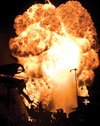

The Tasmanian Electro Metallurgical Company (TEMCO) is a wholly-owned subsidiary of BHP Billiton, and the only manganese ferroalloy plant in Australia. TEMCO supplies this critical steel additive to more than 50 companies around the world. With their four electric arc furnaces, TEMCO can produce more than 250 000 tonnes of manganese alloys per year, 80% of which is exported.
The challenge
Safety is always high on the agenda for TEMCO. In particular, TEMCO was focused on its four electric arc furnaces which, due to their sporadic nature, can experience explosions without any warning. These submerged arc furnaces are identified as the most dangerous furnaces in the world, and it is no surprise that safety issues are of critical concern for TEMCO and BHP Billiton.
Paul Dennis, a process technology supervisor at TEMCO explains: “Sudden explosions are known to arise in these furnaces due to the temperature control mechanism, which pumps water through a series of tubes inside the furnace to maintain the internal temperature. Over time, the water eventually erodes these steel tubes and consequently, causes the water to leak into the furnace.”
The extremely high furnace temperatures and increasing water leakage are the main causes of the sudden explosions. At 400°C to 600°C, the water that enters the furnace through the eroded steel tubes is immediately converted into steam. As this erosion continues and causes more steam to accumulate inside the furnace, the internal pressure builds up until it eventually explodes.
Apart from the disastrous health and safety aspects of any such explosion, companies also need to absorb the exorbitant costs associated with the plant’s closure and downtime. There have been several attempts to solve this disturbing problem with limited success, including attempts to mass balance the water through the system. It was also suggested that the off-gas from the furnace could be monitored for water content. This formed the basis of a study into submerged arc furnaces, to collect data to trend the base level of water in the furnace.
The solution
“A crucial component of my study was my ability to collect accurate and reliable data from the furnace off-gas. “Given the complexity of the environment combined with the high levels of dust involved finding an appropriate instrument proved quite challenging,” Dennis elaborates.
After consulting with industry experts, he was recommended the Siemens LDS6 laser gas analyser. This new technology from Siemens allows for accurate and high-speed monitoring of gas composition in a variety of applications. However, the LDS6 has never been used in a submerged arc furnace application before. In order for Dennis to trial this instrument, a customised analyser specifically modified for TEMCO’s plant environment had to be devised. Extensive consultations occurred between Siemens manufacturers in Germany, a Siemens authorised reseller and BHP Billiton to develop an analyser which was suitable.
Siemens Australia product manager, Brendan Welsh, was one of several Siemens employees involved in coordinating discussions between Germany and Australia. “As part of the extensive discussions around the use of the LDS6 in these furnaces, Siemens were interested in examining TEMCO’s entire process in detail so that the successful modifications could be made to suite their specific environment.
“As this was a first time application for the LDS6 in submerged arc furnaces on a global scale, much caution had to be taken in order to guarantee the analyser’s accuracy, sensitivity, reliability and maintainability.
“One of the major modifications required for this application was to counteract the extremely high levels of dust present at the facility. Around 100 grams of dust per cubic metre was recorded which was much too high for the laser analyser to work accurately.
“Our authorised reseller built an air chamber which was used to blow off the dust from the laser every few minutes. This allowed the laser to gain an accurate scan of the water levels and consequently, delivered consistent and reliable readings,” Welsh reported.
The outcome
The initial trial of the Siemens LDS6 in TEMCO’s submerged arc furnace showed promising results. Small leaks in the furnace which have traditionally been undetected were now able to be monitored using the LDS6, with 100% accuracy. Furthermore, the detected water leaks were confirmed several hours before any other traditional methods can offer. As a result, the data collected from this trial has been instrumental in establishing a set of control limits that will be used to forewarn of any future explosions.
Using this analyser, Dennis was able to observe the water level trends and take action accordingly. In one case, he noticed abnormally high increases in the furnace’s water levels and consequently ordered a shut down of the furnace. “The decision to shut down the furnace was difficult because I was aware of the high costs involved as well as the production downtime it would cause. However, in hindsight, it was worth all the trouble because further examination estimated that an explosion was likely within the next two hours if nothing had been done.”
Dennis is hopeful that with the new LDS6 analyser, submerged arc furnaces will be less of a health and safety concern at BHP Billiton. “Since its commissioning in December 2007, we have been able to work with the LDS6 to develop a safety procedure around this instrument. This is a big step towards achieving zero fatalities in an environment that has been considered highly volatile and unpredictable for many years.”
Key benefits LDS67 gas analyser
* Instant response (less than one second).
* Never needs calibration.
* Minimal maintenance.
* Designed to work in high; temperature (over 1000°C).
* Designed to work in high levels of dust.
* Designed to work in high moisture.
For more information contact Keshin Govender, Siemens Southern Africa, +27 (0)11 652 2412, [email protected], www.siemens.co.za
| Tel: | +27 11 652 2000 |
| Email: | [email protected] |
| www: | www.siemens.co.za |
| Articles: | More information and articles about Siemens South Africa |
© Technews Publishing (Pty) Ltd | All Rights Reserved